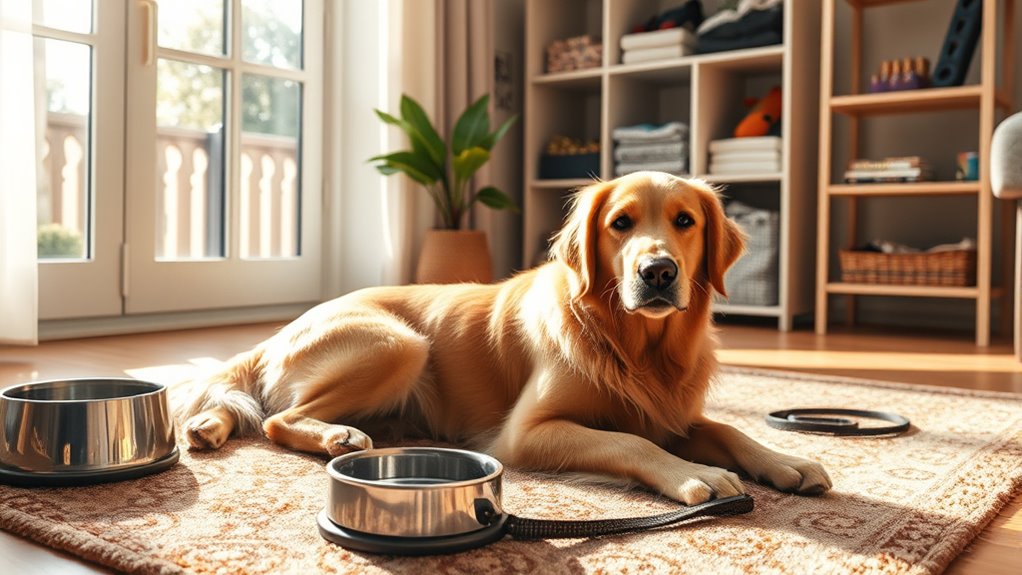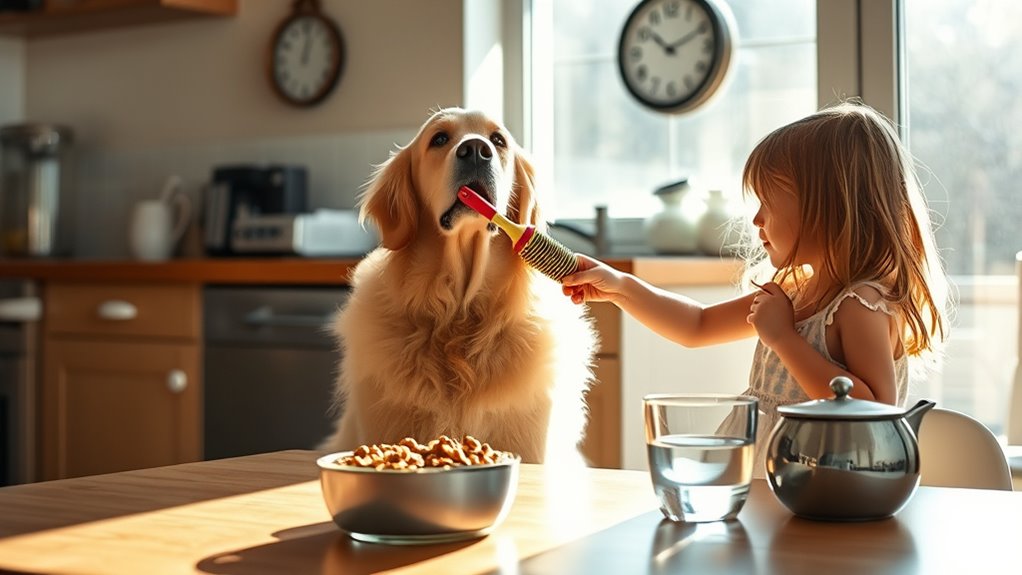Creating a daily routine for your pet helps keep them happy, healthy, and secure. Set consistent meal times using the same bowls and spots to prevent overeating and build positive associations. Incorporate regular activities like walks, play, or interactive toys to maintain physical and mental health. Establish specific times for exercise and feeding, creating a predictable schedule that reduces anxiety and destructive behaviors. Keep your pet’s routine steady—continue to explore how you can make it even better.
Key Takeaways
- Establish consistent feeding times and use the same bowls to create familiarity and support digestion.
- Incorporate regular exercise sessions suited to your pet’s age and breed to promote health and mental stimulation.
- Set daily routines for walks, play, and rest to provide security and reduce behavioral issues.
- Maintain a predictable schedule to strengthen your bond and help your pet feel safe and comfortable.
- Use designated spots for feeding and activities to reinforce structure and positive associations.

Establishing a daily routine for your pet is essential for their well-being and happiness. When you set consistent times for feeding, walking, and play, your pet feels secure and knows what to expect each day. A well-structured routine helps prevent behavioral issues, reduces anxiety, and strengthens your bond. The first step is creating a reliable feeding schedule. Decide on specific times for meals—whether morning and evening or three smaller feedings—and stick to them. Consistency is key because it regulates your pet’s digestion and prevents overeating or begging. Use the same bowls and place the food in a designated spot to foster familiarity. Over time, your pet will associate these times with nourishment and look forward to mealtime, making feeding a positive experience.
Alongside a consistent feeding schedule, designing an exercise plan is equally important. Regular physical activity not only keeps your pet physically healthy but also mentally stimulated. For dogs, this might mean daily walks, fetch sessions in the yard, or agility exercises. Cats benefit from interactive toys, climbing trees, or short play sessions that mimic hunting behaviors. Establish specific times for exercise—perhaps morning and evening—to create a rhythm your pet can anticipate. This predictability helps reduce restlessness and destructive behaviors caused by excess energy or boredom. When you incorporate exercise into your routine, you also create opportunities for bonding and socialization, which are crucial for your pet’s emotional health.
Frequently Asked Questions
How Do I Adjust Routines for a New Puppy or Kitten?
When adjusting routines for a new puppy or kitten, focus on consistent feeding, playtime, and training. Incorporate puppy socialization by introducing new people and environments gradually, and address kitten scratching with appropriate toys and scratching posts. You’ll want to be patient and flexible, ensuring your pet feels safe and loved. This helps them adapt faster and builds a strong bond, making daily life smoother for both of you.
What Should I Feed My Pet During Different Times of the Day?
Think of your pet’s day as a symphony, where each note matters. You should feed your pet based on their nutritional needs and feeding schedules, offering meals at regular times—morning, afternoon, and evening. For puppies and kittens, smaller, more frequent meals work best. Always choose high-quality food suited to their age and health. This consistent rhythm keeps their energy balanced and supports healthy growth.
How Can I Incorporate Exercise Into My Pet’S Daily Schedule?
You can incorporate exercise into your pet’s daily schedule by scheduling regular outdoor walks and engaging in playtime activities. Make sure to set aside specific times each day for these activities to keep your pet active and healthy. Vary the routines to include fetch, tug-of-war, or agility exercises, and take advantage of outdoor spaces for fresh air and stimulation. Consistent exercise improves your pet’s overall well-being and strengthens your bond.
What Are Signs My Pet Is Stressed by the Routine?
Irony strikes when your pet shows signs of stress, despite your best efforts. Watch for pet anxiety signs like excessive barking, pacing, or withdrawal. Behavioral cues such as loss of appetite or unusual aggression can also reveal your routine overwhelms them. These signals help you identify if the schedule causes discomfort, so you can adjust and create a calmer environment, ensuring your pet feels safe and secure.
How Do I Handle Changes in My Pet’S Routine During Travel?
When travel disruptions cause routine changes, you need to handle them gently. Keep routine consistency as much as possible by maintaining feeding times and familiar toys, even in new environments. Gradually introduce your pet to the new surroundings, offering reassurance and comfort. Stick to regular walks and playtimes to reduce stress. Your calm approach helps your pet adapt better to routine changes during travel, making the experience smoother for both of you.
Conclusion
Establishing a daily routine keeps your pet happy and healthy. For example, a dog who eats, walks, and sleeps on a consistent schedule feels more secure and calmer. By sticking to routines, you’ll notice fewer behavioral issues and stronger bonds. Remember, consistency is key—your pet thrives when they know what to expect each day. So, start planning today, and enjoy the peace and joy a well-structured routine brings to both of you.









